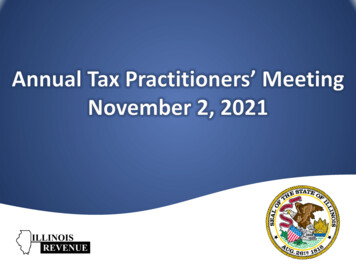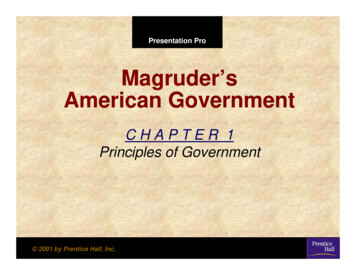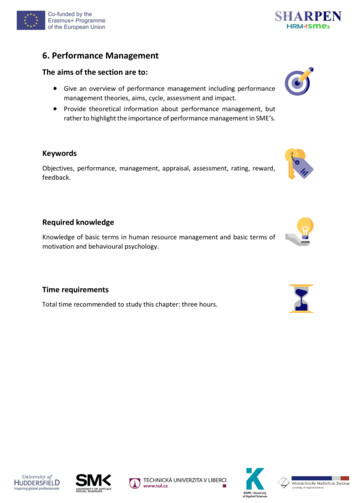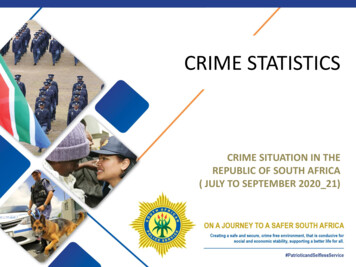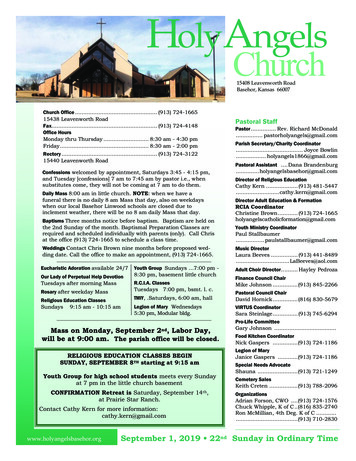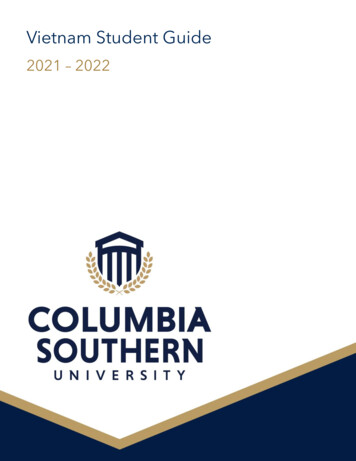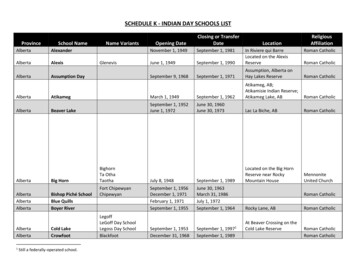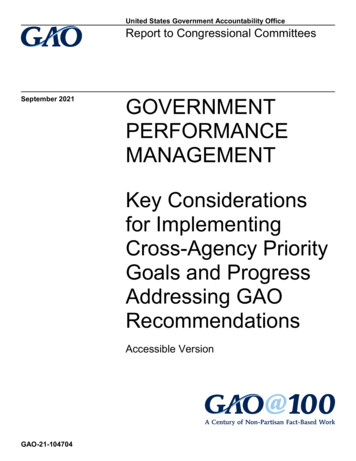
Transcription
United States Government Accountability OfficeReport to Congressional CommitteesSeptember 2021GOVERNMENTPERFORMANCEMANAGEMENTKey Considerationsfor ImplementingCross Agency PriorityGoals and ProgressAddressing GAORecommendationsAccessible VersionGAO-21-104704
GAO HighlightsHighlights of GAO-21-104704, a report tocongressional committeesSeptember 2021GOVERNMENT PERFORMANCEMANAGEMENTKey Considerations for Implementing Cross-AgencyPriority Goals and Progress Addressing GAORecommendationsWhy GAO Did This StudyWhat GAO FoundThe nation faces unprecedentedchallenges that require the federalgovernment to perform better, bemore responsive to the Americanpeople, and achieve greater results.GPRAMA provides important toolsthat can help decision makersaddress crosscutting challengesfacing the federal government.The enactment of the GPRA Modernization Act of 2010 (GPRAMA) aimed tocreate an integrated, crosscutting federal performance planning and reportingframework. The act requires the establishment of 4-year outcome-oriented goalsknown as cross-agency priority (CAP) goals. CAP goals cover a limited numberof mission and management areas, such as improving customer experienceswith federal services. The next set of CAP goals is due no later than February2022.GPRAMA includes a provision forGAO to periodically report on the act’simplementation. This report (1)identifies key considerations that canfacilitate CAP goal implementation;and (2) assesses OMB’s andagencies’ progress in addressingGAO recommendations related toGPRAMA. To identify keyconsiderations, GAO conducted focusgroups with subject matter specialistswith expertise in performancemanagement and with White HouseLeadership Development fellows whohad a role in implementing CAP goals.GAO also obtained views from OMBstaff and reviewed information onOMB’s role in CAP goalimplementation. GAO also reviewedprior work on GPRAMAimplementation. To identify progressmade to address GAOrecommendations, GAO reviewedactions OMB and agencies took since2012.GAO identified key considerations to facilitate CAP goal implementation, forexample:·····Establish the goal: Establish a balanced set of outcome-oriented missionand management-focused goals that reflect the government’s highest policypriorities.Identify goal leaders and contributors: Identify co-leaders and sub-goalleaders to facilitate leadership, continuity, and agency buy-in.Identify resources to support implementation: Dedicate resources to goalimplementation, including funding, staffing, and technology.Use performance information: Focus on improving the quality and use ofdata to routinely assess goal progress and a shared commitment tocontinuous improvement.Report results: Develop communications strategies to help share successstories and outcomes of the goals.The Office of Management and Budget (OMB) and agencies have made notableprogress in implementing 82 of 106 GAO GPRAMA-related recommendationsmade since 2012 (see figure).Status of GAO Recommendations Related to Implementation of the GPRA Modernization Actof 2010, from Fiscal Year 2012-2021 as of July 2021What GAO RecommendsGAO has made 106recommendations related to GPRAMAimplementation, of which 24 have yetto be fully implemented. GAO believesOMB and the agencies should fullyaddress the remainingrecommendations. OMB stated that ithad no comments on the report.View GAO-21-104704. For more information,contact Alissa H. Czyz at (202) 512-6806 orczyza@gao.gov.Accessible Data for Status of GAO Recommendations Related to Implementation of the GPRAModernization Act of 2010, from Fiscal Year 2012-2021 as of July 2021CategoryImplementedNot fully(number ofimplementedrecommendations) (number ofrecommendations)Office of Management and Budget3617Agencies467United States Government Accountability Office
For example, OMB issued guidance to agencies to expand the use of data-drivenperformance reviews, and agencies took steps to report on the quality of theirperformance information. However, OMB and agencies have not fullyimplemented 24 GAO recommendations in areas such as creating an inventoryof federal programs and improving the transparency of publicly reportedperformance information. Implementing remaining recommendations would helpOMB and agencies more effectively manage performance.
ContentsGAO Highlights2Why GAO Did This StudyWhat GAO RecommendsWhat GAO Found2221BackgroundKey Considerations that Can Facilitate CAP Goal ImplementationOMB and Agencies Have Made Progress Addressing OurRecommendations on GPRAMA ImplementationAgency CommentsAppendix I: Cross Agency Priority Goals and Goal Statements 2018-202247233739Appendix II: Subject Matter Specialists44Appendix III: Objectives, Scope and Methodology46Appendix IV: Status of Our Recommendations on Implementation of the GPRA Modernization Act49Appendix V: Examples of Our Recommendations to Address Crosscutting Challenges 2018-August 202184Appendix VI: Examples of Our Recommendations to Address Performance Measurement Challenges, byProgram Type, 2017-June 202187Appendix VII: GAO Contact and Staff Acknowledgements91LetterGAO ContactStaff Acknowledgments919192Related GAO ProductsTablesTable 1: Selected Leadership Positions within Agencies andCouncils for GPRA Modernization Act (GPRAMA)ImplementationTable 2: Examples of High-Risk Areas Requiring FederalLeadership and Crosscutting StrategiesTable 3: Status of Our Recommendations Related toImplementation of the GPRA Modernization Act, from2012-2021, as of July 2021Page i61249GAO-21-104704 Government Performance Management
Table 4: Recommendations that OMB Has Implemented fromGAO’s Work Related to the GPRA Modernization Act of201051Table 5: Recommendations that OMB Has Not Fully Implementedfrom GAO Work Related to the GPRA Modernization ActTable 6: Recommendations Agencies Have Implemented fromOur Work Related to the GPRA Modernization ActTable 7: Recommendations that Agencies Have Not FullyImplemented from Our Work Related to the GPRAModernization ActTable 8: Examples of Our Recommendations to AddressCrosscutting ChallengesTable 9: Examples of Our Recommendations to AddressPerformance Measurement Challenges, by Program Type6169818588FiguresFigure 1: Key Considerations to Facilitate the Implementation ofCross-Agency Priority GoalsAccessible Information for Figure 1: Key Considerations toFacilitate the Implementation of Cross-Agency PriorityGoalsFigure 2: Status of Our Recommendations Related toImplementation of the GPRA Modernization Act fromFiscal Year 2012-2021, as of July 2021Accessible Data for Figure 2: Status of Our RecommendationsRelated to Implementation of the GPRA ModernizationAct from Fiscal Year 2012-2021, as of July 2021Figure 3: Cross Agency Priority Goals and Goal Statements 20182022Accessible Information for Figure 3: Cross Agency Priority Goalsand Goal Statements 2018-2022Figure 4: Cross Agency Priority Goals and Goal Statements 20182022 (continued)Accessible Information for Figure 4: Cross Agency Priority Goalsand Goal Statements 2018-2022 (continued)Page ii89262740414243GAO-21-104704 Government Performance Management
DATA ActDHSDODDOEDOJDOTEOPEPAEvidence ANDAANOAANRCNSFOMBPage iiiagency priority goalsagency financial reportAssociation of Government AccountantsAnimal Plant and Health Inspection Serviceagency performance planannual performance plan and reportannual performance reportAmerican Society for Public Administrationcross-agency priorityCustoms and Border Protectionchief operating officerDigital Accountability and Transparency Act of 2014Department of Homeland SecurityDepartment of DefenseDepartment of EnergyDepartment of JusticeDepartment of TransportationExecutive Office of the PresidentEnvironmental Protection AgencyFoundations for Evidence-Based PolicymakingAct of 2018Federal Energy Regulatory CommissionFederal Program InventoryFederal Student AidFederal Transit AdministrationFish and Wildlife Servicefiscal yearGovernment Performance Results Act of 1993GPRA Modernization Act of 2010General Services AdministrationDepartment of Health and Human ServicesInternal Revenue Serviceliquefied natural gasNational Academy of Public AdministrationNational Aeronautics and Space AdministrationWilliam M. (Mac) Thornberry National DefenseAuthorization Act for Fiscal Year 2021National Oceanic and Atmospheric AdministrationU.S. Nuclear Regulatory CommissionNational Science FoundationOffice of Management and BudgetGAO-21-104704 Government Performance Management
OPMOSSPIPHMSAPICPIOPMCSBASTEMUSAIDUSDAVAWHLD fellowsOffice of Personnel ManagementOffice of Shared Solutions and PerformanceImprovementPipeline and Hazardous Materials SafetyAdministrationPerformance Improvement CouncilPerformance Improvement OfficerPresident’s Management CouncilSmall Business Administrationscience, technology, engineering, and mathematicsU.S. Agency for International DevelopmentDepartment of AgricultureDepartment of Veterans AffairsWhite House Leadership Development ProgramfellowsThis is a work of the U.S. government and is not subject to copyright protection in theUnited States. The published product may be reproduced and distributed in its entiretywithout further permission from GAO. However, because this work may containcopyrighted images or other material, permission from the copyright holder may benecessary if you wish to reproduce this material separately.Page ivGAO-21-104704 Government Performance Management
441 G St. N.W.Washington, DC 20548LetterSeptember 28, 2021Congressional CommitteesThe nation faces unprecedented challenges that require the federalgovernment to perform better, be more responsive to the Americanpeople, and achieve greater results. Major issues facing the nationinclude the Coronavirus Disease 2019 pandemic, racial equity, long-termfiscal sustainability, and climate change. Further, the federal governmentfaces significant budget, management, and performance challenges as itseeks to achieve results for the American people. For example, in annualreports issued from 2011 to 2021, we identified more than 350 areas andmore than 1,100 actions for Congress or executive branch agencies toreduce, eliminate, or better manage fragmentation, overlap, andduplication; achieve other cost savings; or enhance revenue.1In addition, government-wide and individual agency weaknesses inmanagement capacity impair efficient and effective governmentoperations. In the 2021 update to our High-Risk List, we identified 36areas that need broad-based transformation or are vulnerable to fraud,waste, abuse, or mismanagement. The list includes many persistentcrosscutting issues that agencies have been working to address overtime.2 Concerted action on High-Risk List areas is vital to build thecapacity of the federal government and make progress on the current andemerging challenges facing the nation.The performance planning and reporting framework originally put intoplace by the Government Performance Results Act of 1993 (GPRA), andsignificantly enhanced by the GPRA Modernization Act of 2010(GPRAMA), provides important tools that can help decision makersaddress challenges facing the federal government.3 Among other things,GPRAMA requires the Office of Management and Budget (OMB) tocoordinate with agencies to develop federal government priority goals1Seeour Duplication and Cost Savings webpage for links to the 2011 to 2021 annualreports: igh Risk Series: Dedicated Leadership Needed to Address Limited Progress inMost High-Risk Areas, GAO-21-119SP (Washington, D.C.: Mar. 2, 2021).3Pub.L. No. 103-62, 107 Stat. 285 (1993); Pub. L. No. 111-352, 124 Stat. 3866 (2011).Page 1GAO-21-104704 Government Performance Management
Letter(known as cross-agency priority (CAP) goals)—4-year outcome-orientedgoals covering a number of crosscutting mission areas—as well as goalsto improve management across the federal government.4 The most recentCAP goals were established in 2018. See appendix I for a list of the 20182022 CAP goals and goal statements. These include goals such as: (1)Improving Customer Experience with Federal Services; (2) ResultsOriented Accountability for Grants; and (3) Modernizing the InfrastructurePermitting Process. The next set of CAP goals is due no later thanFebruary 2022. However, the current administration may issue the nextset of CAP goals in advance of that date.GPRAMA includes a provision for us to periodically evaluate and reporton its implementation.5 Since 2012, we have issued more than 30products in response to this provision.6 This report (1) identifies keyconsiderations that can facilitate the implementation of CAP goals, and(2) assesses the progress OMB and agencies have made in addressingour recommendations related to GPRAMA implementation.To identify key considerations to facilitate the implementation of CAPgoals, we conducted four focus groups in March and April 2021. Twofocus groups consisted of a total of 17 subject matter specialists withexpertise in performance management. Appendix II includes a list of thesubject matter specialists who participated in the focus groups. The othertwo groups consisted of a total of 15 White House LeadershipDevelopment Program fellows (WHLD fellows) who were involved inimplementing CAP goals and related activities from 2019 and 2020.7 Theviews of the fellows and subject matter specialists are not generalizableto the larger populations of WHLD fellows and subject matter specialistswith expertise in performance management, nor do they necessarilyrepresent the views of all CAP goal teams.To further aid in our identification of key considerations to facilitate theimplementation of CAP goals, we obtained views from OMB, the General431U.S.C. § 1120(a).5Pub.6SeeL. No. 111-352, § 15(b)(2), 124 Stat. at 3883–3884.the Related Products at the end of this report.7TheWhite House Leadership Development Program engages an annual cohort of GS-15career employees to work on the federal government’s highest priority and highest impactchallenges. The program is sponsored by the Executive Office of the President andmanaged by the General Services Administration.Page 2GAO-21-104704 Government Performance Management
LetterServices Administration (GSA), and Performance Improvement Council(PIC) staff (housed in GSA) who were involved in establishing andmanaging CAP goals. We reviewed agency documents and informationabout CAP goals on Performance.gov, a public website. Further, wereviewed our prior reports on CAP goals, collaboration, and performancemanagement and literature published by the subject matter specialistswho participated in our focus groups.8To identify key considerations to facilitate the implementation of CAPgoals, we conducted a content analysis of the focus group results, agencyinformation, our prior reports, and literature published by our selectedsubject matter specialists. We shared our initial list of key considerationswith the focus group participants for their technical comments and views,and incorporated their comments as appropriate. We did not assess theimplementation of the 2018-2022 CAP goals because a new set of CAPgoals was being established during our review.To evaluate the extent to which agencies have addressedrecommendations related to GPRAMA implementation, we reviewed ourrelated prior work and actions OMB and agencies have taken sinceGPRAMA was enacted.9 Specifically, we examined the progress OMBand agencies have made in addressing our recommendations concerningGPRAMA implementation or requirements. We present thoserecommendations and related progress updates by four themespreviously identified by our GPRAMA-related work: (1) addressing crosscutting issues, (2) use of performance information, (3) daily operations’alignment with results, and (4) transparent and open government.10 To8GAO,Managing for Results: OMB Improved Implementation of Cross-Agency PriorityGoals, But Could Be More Transparent About Measuring Progress, GAO-16-509(Washington, D.C.: May 20, 2016); Managing for Results: OMB Should StrengthenReviews of Cross-Agency Goals, GAO-14-526 (Washington, D.C.: June 10, 2014);Managing for Results: A Guide for Using the GPRA Modernization Act to Help InformCongressional Decision Making. GAO-12-621SP (Washington, D.C. June 15, 2012);Managing for Results: GAO’s Work Related to the Interim Crosscutting Priority Goalsunder the GPRA Modernization Act, GAO-12-620R (Washington, D.C.: May 31, 2012);Results-Oriented Cultures: Implementation Steps to Assist Mergers and OrganizationalTransformations, GAO-03-669 (Washington, D.C.: July 2, 2003); and Executive Guide:Effectively Implementing the Government Performance and Results Act,GAO/GGD-96-118 (Washington, D.C.: June 1, 1996).9GAO,Managing for Results: Further Progress Made in Implementing the GPRAModernization Act, but Additional Actions Needed to Address Pressing GovernanceChallenges, GAO-17-775 (Washington, D.C.: Sept. 29, 2017).10GAO-17-775.Page 3GAO-21-104704 Government Performance Management
Letterobtain the updated status of recommendations that have yet to beimplemented, we reviewed our current and prior work, communicated withOMB staff and agency officials, and reviewed related agency documents.We also discussed successful practices the subject matter specialistsviewed as important to the implementation of GPRAMA. Appendix IIIincludes more details on our objectives, scope, and methodology.We conducted this performance audit from January 2021 to September2021 in accordance with generally accepted government auditingstandards. Those standards require that we plan and perform the audit toobtain sufficient, appropriate evidence to provide a reasonable basis forour findings and conclusions based on our audit objectives. We believethat the evidence obtained provides a reasonable basis for our findingsand conclusions based on our audit objectives.BackgroundMore than 10 years ago, the enactment of GPRAMA updated the GPRAto create a more integrated, crosscutting performance planning andreporting framework at both the government-wide and agency levels.GPRAMA and related guidance established the following requirementsand practices:·CAP goals: At the government-wide level, at least every 4 yearsOMB is to coordinate with agencies to establish CAP goals. CAPgoals are outcome-oriented crosscutting goals that cover a limitednumber of mission areas and management areas.11 For example, the2018-2022 mission-focused CAP goals covered issues such asinfrastructure permitting and security clearance reform, and themanagement-focused goals covered issues such as human capital,customer service, and improper payments.·Agency priority goals (APGs): At the agency level, every 2 years,GPRAMA requires that the heads of certain agencies, in consultationwith OMB, identify a subset of agency performance goals to reflect theagencies’ highest priorities.121131U.S.C. § 1120(a). For more information on current and prior CAP goals, seewww.performance.gov.1231U.S.C. § 1120(b).Page 4GAO-21-104704 Government Performance Management
Letter·Data-driven reviews: Agency leaders and managers are to meet atleast quarterly to review data and drive progress toward keyperformance goals and other management-improvement priorities.Similarly, the Director of OMB, with relevant parties, is to reviewprogress toward each CAP goal.13·Strategic Reviews: OMB guidance implementing GPRAMA directsagency leaders to annually assess progress toward achieving eachstrategic objective using a broad range of evidence.14·Federal program inventory: GPRAMA, as amended, requires OMBto make a list of all federal programs identified by agencies publiclyavailable on a central government-wide website.15 For each program,the information on the website is to include a description of thepurposes of the program, how the program contributes to theagency’s missions and goals, funding for the current fiscal year andthe previous 2 fiscal years among other financial information, thecontribution of the program activity to the agency’s mission and goals,and related evaluations, among other things.16·Public website: GPRAMA requires a single, government-wideperformance website to communicate government-wide and agencyperformance information. Among other things, the website—implemented by OMB as Performance.gov—is to include (1)information on CAP goals and APGs, including quarterly progressupdates, and (2) agency strategic plans, annual performance plans,and annual performance reports.171331U.S.C. § 1121(a), (b).14OMB,Preparation, Submission and Execution of the Budget, Circular No. A-11, part 6,(July 2020).1531U.S.C. § 1122(a). GPRAMA as originally enacted include a provision requiring aninventory of federal programs. Pub. L. No. 111-352, § 7, 124 Stat. 3866, 3876 (2011). TheWilliam M. (Mac) Thornberry National Defense Authorization Act for Fiscal Year 2021expanded these requirements. Pub. L. No. 116-283, div. H, § 9601, 134 Stat. 3388, 4823–4828 (2021).16GPRAMAdefines program activity as specific activity or project as listed in the programand financing schedules of the annual budget of the U.S. government. 31 U.S.C. §1115(h)(11).1731U.S.C. § 1122; OMB, Circular No. A-11, pt. 6, § 210.5 (2020). The federal programinventory is to be made available on Performance.gov or another appropriate federalgovernment website where related information is made available, as determined by OMB.31 U.S.C. § 1122(a)(2)(B).Page 5GAO-21-104704 Government Performance Management
LetterGPRAMA and related guidance also established leadership positions anda council, as shown in table 1:Table 1: Selected Leadership Positions within Agencies and Councils for GPRA Modernization Act (GPRAMA) ImplementationLeadership positionsand councilRoles and responsibilitiesChief Operating Officer The deputy agency head is designated COO, with overall responsibility for improving agency management(COO)and performance (31 U.S.C. § 1123).PerformanceImprovement Officer(PIO)The PIO reports directly to the COO and assists the agency head and COO with various performancemanagement activities (31 U.S.C. § 1124(a)).Goal leadersGoal leaders develop strategies to achieve goals, manage execution, and regularly review performance.GPRAMA requires goal leaders for CAP goals and agency performance goals, including APGs (31 U.S.C. §§1115(a)(3), (b)(5)(E), 1120(b)(1)(C)).PerformanceImprovement Council(PIC)The PIC assists OMB with improving the performance of the federal government and achieving the CAPgoals. This includes facilitating the exchange of useful practices and developing tips and tools to strengthenagency performance management. The PIC is chaired by the Deputy Director for Management at OMB andincludes agency PIOs from each of the 24 Chief Financial Officers Act agencies (31 U.S.C. § 1124(b)).President’sManagement Council(PMC)The PMC, established by Presidential memorandum, is comprised of OMB’s Deputy Director forManagement and the COOs of major departments and agencies, among other individuals. Its responsibilitiesinclude improving overall executive branch management and implementing the President’s ManagementAgenda.Source: GAO analysis of GPRAMA and OMB guidance. GAO-21-104704OMB, GSA, and the White House Leadership Development Program(WHLD) fellows also have roles in implementing GPRAMA.·OMB: GPRAMA directs OMB to coordinate with agencies to developCAP goals and develop a federal government performance plan onhow CAP goals will be achieved.18 OMB also develops federalprogram inventory and implements Performance.gov.19 Further, OMBhas provided guidance to agencies for implementing GPRAMA andsubsequent laws in its annual budget guidance, Circular No. A-11.20 Inrecent years, OMB has used that guidance to integrate the1831U.S.C. §§ 1115(a), 1120(a).1931U.S.C. § 1122.20See,OMB, Preparation, Submission and Execution of the Budget, Circular No. A-11,part 6, (July 2020).Page 6GAO-21-104704 Government Performance Management
Letterimplementation of various laws and initiatives, including GPRAMA,into the Federal Performance Framework.21·GSA: GSA’s Office of Shared Solutions and PerformanceImprovement (OSSPI) works closely with OMB to support CAP goalimplementation. OSSPI also supports the PIC and other executivecouncils.·WHLD Program Fellows: The fellows are assigned to CAP goalteams and other cross-agency initiatives to expose emerging agencyleaders to cross-agency issues and address the need for strongleadership on the CAP goals, while leveraging existing resources.Key Considerations that Can Facilitate CAPGoal ImplementationCAP goals are designed to focus on longer-term or complex outcomesinvolving multiple agencies, programs, or entities. The nature of the CAPgoals is such that managing their successful implementation can bechallenging. The focus groups, our prior reports, and agency documentsresulted in the identification of 10 key considerations (see figure 1) to helpfacilitate the implementation of GPRAMA requirements and related OMBguidance. We grouped these key considerations into five broad actionsfor CAP goal implementation, drawn from GPRAMA requirements andprior work.2221OnDecember 23, 2020, OMB revised OMB Circular A-11 and removed guidance on theFederal Performance Framework in its entirety to reduce the burden and expense bystreamlining or eliminating processes that the prior administration described as not leadingto impactful change or measurable efficiencies. In March 2021, OMB reinstated thisguidance. The memorandum re-establishing this guidance stated that OMB will work inpartnership with agencies and seek input from key stakeholders inside and outsidegovernment to identify improvements that can be made to the effectiveness of theperformance framework. For more information, see: OMB, OMB-M-21-22, Update toImplementation of Performance Management Statutes. March 24, 2021.22Thekey considerations were developed from our focus group discussions with formerWHLD fellows and subject matter specialists and their supporting research, OMB andGSA information, and our prior work and leading practices on CAP goals, collaboration,and performance management. For example, in 2017, the PIC identified lessons learnedand best practices for CAP goals through interviews with CAP goal leaders and teams.Considerations for CAP Goal Success, GSA (2017). Some of our key considerations areconsistent with our prior work on leading collaboration practices and best practicesidentified by the PIC. The five CAP goal actions are based on GPRAMA requirements andour prior work. See GAO-16-509.Page 7GAO-21-104704 Government Performance Management
LetterFigure 1: Key Considerations to Facilitate the Implementation of Cross-Agency Priority GoalsPage 8GAO-21-104704 Government Performance Management
LetterAccessible Information for Figure 1: Key Considerations to Facilitate the Implementation of Cross-Agency Priority GoalsActions to implement cross-agencypriority (CAP) goalsKey considerationsEstablish the goal··Identify goal leaders and contributors··Identify resources to supportimplementation··Establish a balanced set of outcome-oriented mission and management-focusedgoals that reflect the government’s highest policy priorities.Engage goal teams and key stakeholders in early development of outcome-orientedgoals and performance measures.Identify co-leaders and sub-goal leaders to facilitate leadership, continuity, andagency buy-in.Clarify and agree on roles, responsibilities, and decision-making processes for goalteams.Dedicate resources to goal implementation, including funding, staffing, andtechnology.Create a repository of lessons learned to share across goal teams.Use performance information·Focus on improving the quality and use of data to routinely assess goal progress anda shared commitment to continuous improvement.Report results·Report on actions taken to develop performance measures and other progressmeasures.Assess and report progress on goal achievement at the end of the goal periods.Develop communications strategies.··Page 9GAO-21-104704 Government Performance Management
LetterGPRAMA-Related RequirementsGPRAMA requires OMB to coordinate withagencies to develop priority goals to improvethe performance and management of thefederal government. These goals are toinclude (1) outcome-oriented goals covering alimited number of cross cutting policy areas,and (2) goals for management improvementsneeded across the federal governmentincluding financial management, humancapital management, information technologymanagement, procurement and acquisitionmanagement, and real property management.The goals are to be long term in nature andupdated or revised at least every 4 years.When developing adjusting the goals, OMB isrequired to consult periodically or at leastonce every 2 years with Congress.OMB is required to identify majormanagement challenges (such as issues weidentified as high risk or issues identified byan Inspector General) that are governmentwide or cross cutting in nature and describeplans to address such challenges, includingrelevant performance goals, performanceindicators, and milestones.OMB guidance A-11 states that agenciesshould build coalitions internally and withother federal agencies, and engage deliverypartners such as state and local governments,and nonprofit and private sector organizationsto achieve program goals.Source: 31 U.S.C. §§ 1115(a)(6), 1120(a), OMB Circular A11, Preparation, Submission, and Execution of the Budget,pt. 6, § 220.12 (April 2021). GAO-21-104704Establish the GoalEstablish a balanced set of outcome-oriented mission andmanagement-focused goals that reflect the government’s highestpolicy priorities. Both WHLD fellows and subject matter specialists inour focus groups said CAP goals should reflect the government’s highestpolicy priorities with support from the President’s Management Council,and other high
Performance Measurement Challenges, by Program Type 88 Figures Figure 1: Key Considerations to Facilitate the Implementation of Cross-Agency Priority Goals 8 Accessible Information for Figure 1: Key Considerations to Facilitate the Implementation of Cross-Agency Priority Goals 9 Figure 2: Status of Our Recommendations Related to
